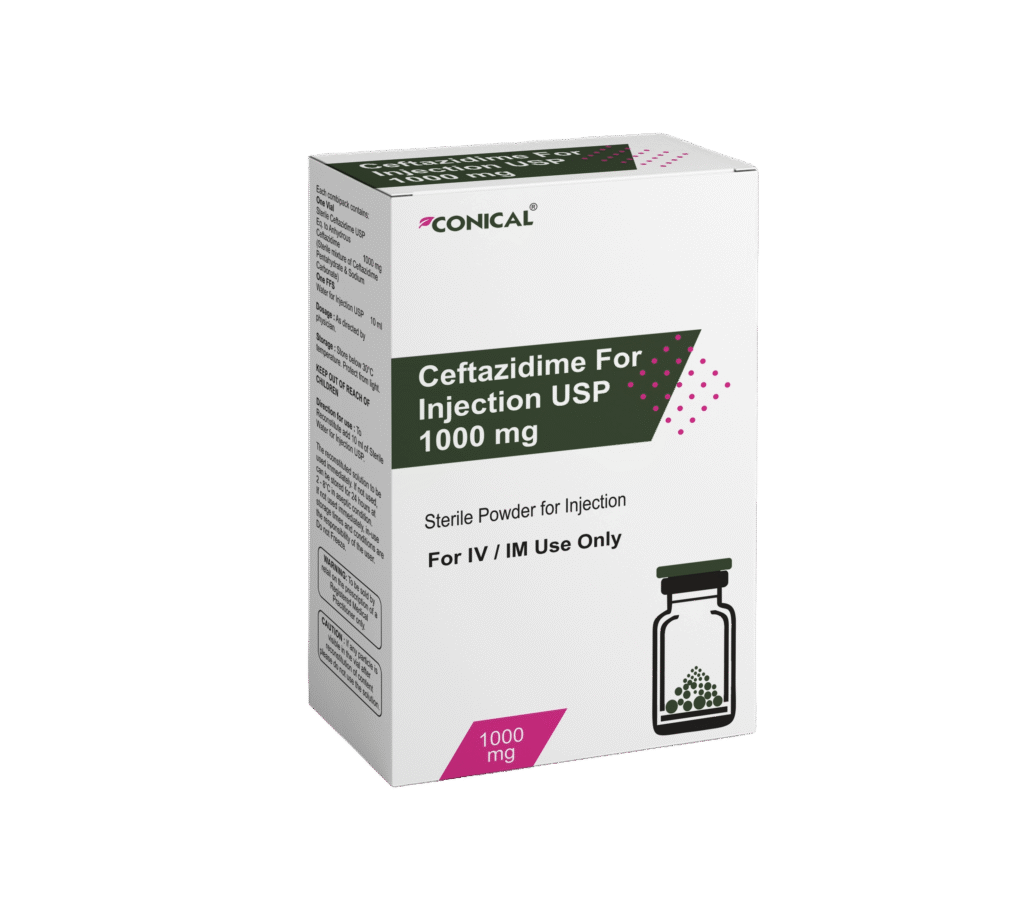







What are the uses of Ceftazidime Injection 1gm?
Ceftazidime Injection 1gm inhibits bacterial cell wall synthesis following attachment to penicillin-binding proteins (PBPs). This results in the interruption of cell wall (peptidoglycan) biosynthesis, which leads to bacterial cell lysis and death.
Precautions While Using Ceftazidime Injection 1gm
1. Allergic Reactions (Hypersensitivity)
2. Limited Effectiveness
3. Diarrhoea and Colitis
4. Kidney Health
5. Overgrowth of Other Germs
6. Lab Test Interference
7. Sodium Content
Dosages of Ceftazidime Injection 1gm
Adults and Children Over 40 kg (about 88 lbs)
Given in Separate Doses (Intermittent)
Given All Day Through a Drip (Continuous Infusion)
Children Under 40 kg
Given in Separate Doses
Given All Day Through a Drip
Newborns and Babies Under 2 Months
Giving Ceftazidime Injection 1gm slowly all day (continuous infusion) is not recommended for babies under 2 months.
Older Adults (Over 80 Years)
Liver Problems
For serious liver problems, the doctor will monitor closely.
Kidney Problems
Adults and Children Over 40 kg
| Kidney Function | Dose | How Often |
|---|---|---|
| Mild (50–31 ml/min) | 1 g | Every 12 hours |
| Moderate (30–16 ml/min) | 1 g | Every 24 hours |
| Severe (15–6 ml/min) | 0.5 g | Every 24 hours |
| Very severe (<5 ml/min) | 0.5 g | Every 48 hours |
Start with 1 g as a loading dose. For serious infections, the doctor may increase the dose or give it more often.
Children Under 40 kg
| Kidney Function | Dose (mg/kg) | How Often |
|---|---|---|
| Mild (50–31 ml/min) | 25 | Every 12 hours |
| Moderate (30–16 ml/min) | 25 | Every 24 hours |
| Severe (15–6 ml/min) | 12.5 | Every 24 hours |
| Very severe (<5 ml/min) | 12.5 | Every 48 hours |
Dialysis Patients
Haemodialysis
Peritoneal Dialysis (CAPD)
Haemofiltration (CVVH or CVVHD)
Possible Side Effects of Ceftazidime Injection 1gm
Ceftazidime Injection 1gm may cause side effects in some people. These can range from mild to serious. Below is a summary of known side effects, grouped by how often they happen and which part of the body they affect.
Frequency Guide
Infections
Blood Disorders
Immune System
Nervous System
Veins
Digestive System
Liver
Skin
Kidneys
General Symptoms
Lab Tests
Store below 30°C temperature. Protect from light.
Keep the medicine out of reach of children.
10 ml clear glass vial with a bromobutyl rubber stopper, sealed with a flip-off aluminum seal.
Ceftazidime Injection 1gm in glass vial is supplied with 10 ml plastic ampoule of diluent (Sterilized Water for Injections USP) in unit carton with pack insert
Contact us directly to receive full information on the product, the formulation, the science behind it, stability data, and more. Our Business Development Manager is a click away.
Questions are useful tools, they open lines of communication; give us information; improve interactions, facilitate analysis, and many more.
A pharma CMO is a special kind of an organization, offering contract manufacturing services to pharmaceutical companies for various kinds of drug formulations.
Reduce overall costs and time to market :
Contract manufacturers already have the needed infrastructure and technical staff, so working with a CMO or CDMO can decrease the cost of manufacturing your pharmaceutical products.
Scalability and flexible production capacity :
You can produce what you need when you need it without worrying about excess capacity. Additionally, CMOs understand the importance of quality and compliance, so you don't have to sacrifice safety for scalability.
Save on upgrading and maintaining equipment :
If you have your manufacturing facility, you’ll have to pay to upgrade your equipment as technology advances—which can get expensive. A CMO/CDMO’s only function is to make and distribute products, so part of their core business responsibility is to update their equipment whenever needed and perform maintenance.
Ease supply chain issues :
During the pandemic, there were several instances of supply chain issues, including medicine shortages. CMOs are generally better equipped than startups to handle a supply chain crisis.
Bandwidth to focus on core competencies
When your company resources aren’t directly allocated to manufacturing and distribution, you have more time to focus on other tasks, like marketing your new drug, researching, or working on drug discovery.
We have 7+ manufacturing sites with a minimum of WHO GMP certification and other country-specific approvals like NAFDAC approved, PPK Kenya Approved, TFDA Tanzania Approved, EU-GMP Approved.
We have below manufacturing capacity:
For Tablet, Capsule, and soft gel: up to 1 million units per shift
For Syrup: up to 0.05 Million per shift
For Ampoule and Vial: up to 0.1 million units per shift
For Ointment and Cream: up to 0.1 million units per shift
For Suppository: 0.1 Million units per shift
